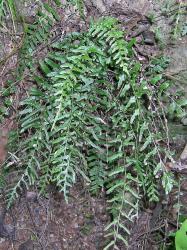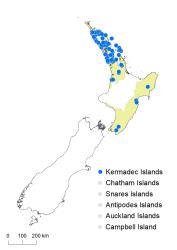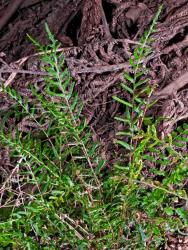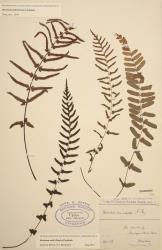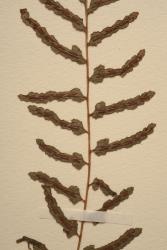- ≡ Doodia mollis Parris, New Zealand J. Bot. 18: 145 (1980)
Rhizomes erect, up to 30 mm tall (in herbarium material), bearing scales. Rhizome scales linear to narrowly ovate, 2–4.5 mm long, 0.2–0.3 mm wide, pale brown, concolorous. Fronds weakly dimorphic; sterile fronds 70–390 mm long, forming a prostrate or semi-erect rosette; fertile fronds on same plant usually longer, 110–620 mm long, arranged centrally, held semi-erect. Sterile fronds. Stipes 5–120 mm long, black-brown proximally, becoming red- or yellow-brown distally, bearing pale brown narrowly ovate scales, and minute colourless hairs. Rachises yellow-brown, grooved adaxially, bearing hairs and occasional scales. Laminae 55–275 mm long, 12–50 mm wide or rarely to 74 mm wide, pinnatisect to 1-pinnate or rarely 2-pinnate proximally, narrowly elliptic to linear, tapering to a short pinnatifid apex, similar colour on both surfaces, usually tinged red when young, herbaceous, bearing minute hairs and occasional scales on midveins, lacking tubercles. Pinnae in 7–21 pairs, widely spaced, ovate to oblong, straight, reducing only slightly at the base of the lamina; the longest at about the middle, 7–38 mm long, the widest at the base, 3–14 mm wide, apices obtuse to rounded, margins sharply serrate; the basal pinnae opposite; the terminal pinna 12–45 mm long, usually <⅛ of total frond length. Veins anastomosing. Fertile fronds. Stipes 15–230 mm long. Rachises yellow-brown, grooved adaxially, bearing hairs and occasional scales. Laminae 85–390 mm long, 9–56 mm wide, rarely to 100 mm wide. Pinnae in 8–32 pairs, ovate or narrowly ovate, straight, reducing only slightly at the base of the lamina, bearing basal acroscopic and basiscopic lobes; pinnae 5–34 mm long, or rarely to 55 mm long, with the longest at about the middle, 2–13 mm wide, and the widest at the base; apices acute on distal pinnae, obtuse on proximal pinnae; margins sharply serrate; distal pinnae decurrent or adnate on c. ⅓ of lamina, proximal pinnae stalked or sessile on c. ⅔ of lamina; the terminal pinna 12–45 mm long. Proximal pair of pinnae rarely divided into stalked secondary pinnae up to 8 mm long and 5 mm wide. Veins anastomosing. Sori elongated, discrete or confluent, in one row either side of midvein; indusia narrowly oblong, 1–4 mm long or ± continuous along length of pinna, opening towards the midvein, minutely hairy.
Blechnum molle, previously included in the genus Doodia, is recognised by its weakly dimorphic fronds, young fronds which are tinged pink, and anastomosing venation. It is distinguished from B. kermadecense, B. neohollandicum and B. parrisiae by its pinnae, which are adnate only in the upper third of the rachis. It is most similar to B. zeelandicum, from which it is distinguished by its much shorter terminal pinna segment, and by the presence of hairs on the rachis. It is further distinguished by its characteristic fertile pinnae, which bear basal basiscopic and acroscopic lobes, rather than just acroscopic lobes, and by its hexaploid rather than tetraploid chromosome number.
Blechnum molle is closely related to B. spinulosum Poir., which is endemic to Australia, but distinguished by its shorter terminal pinna, larger auricles, and fewer pairs of pinnae (Parris 1980). Chromosome numbers of n = 64 and n = c. 120 have been reported in Australia, in contrast to n = c. 96 in New Zealand (Tindale & Roy 2002).
Aberrant forms are known with the basal pair of primary pinnae greatly extended and divided into multiple secondary pinnae.
North Island: Northland, Auckland, Gisborne, Southern North Island.
Kermadec Islands.
Altitudinal range: 0–220 m.
Blechnum molle occurs on Macauley Island (AK 325817), and possibly on South Meyer Island (AK 330839) in the Kermadec Islands. It also occurs in lowland areas of the North Island from Kaitāia to Kāwhia, with more scattered occurrences on the east coast from around Gisborne, Napier, and in southern Wairarapa. It reaches 220 m in Puketi Forest, Northland.
Blechnum molle is a terrestrial fern found in podocarp and broadleaved forest, under kānuka, in open scrub, and in coastal bush. It grows on stream banks, near waterfalls, at the base of tree trunks, on clay banks and rocky bluffs, in humus hummocks on the forest floor, under overhangs, and among damp rocks.
Blechnum molle was given a conservation status of At Risk/Naturally Uncommon by de Lange et al. (2018).
There is evidence for hybridisation between Blechnum molle and B. parrisiae (see Blechnum ×digenum; Parris 1972).
n = c. 96 (Brownlie 1961 – as Doodia caudata).
This species has been widely misidentified in most earlier New Zealand Floras as Doodia caudata (Cav.) R.Br., now treated as Blechnum spinulosum Poir. It was recognised as the New Zealand endemic D. molle, distinct from Doodia caudata, by Parris (1980), and later transferred to Blechnum by Christenhusz et al. (2011).



